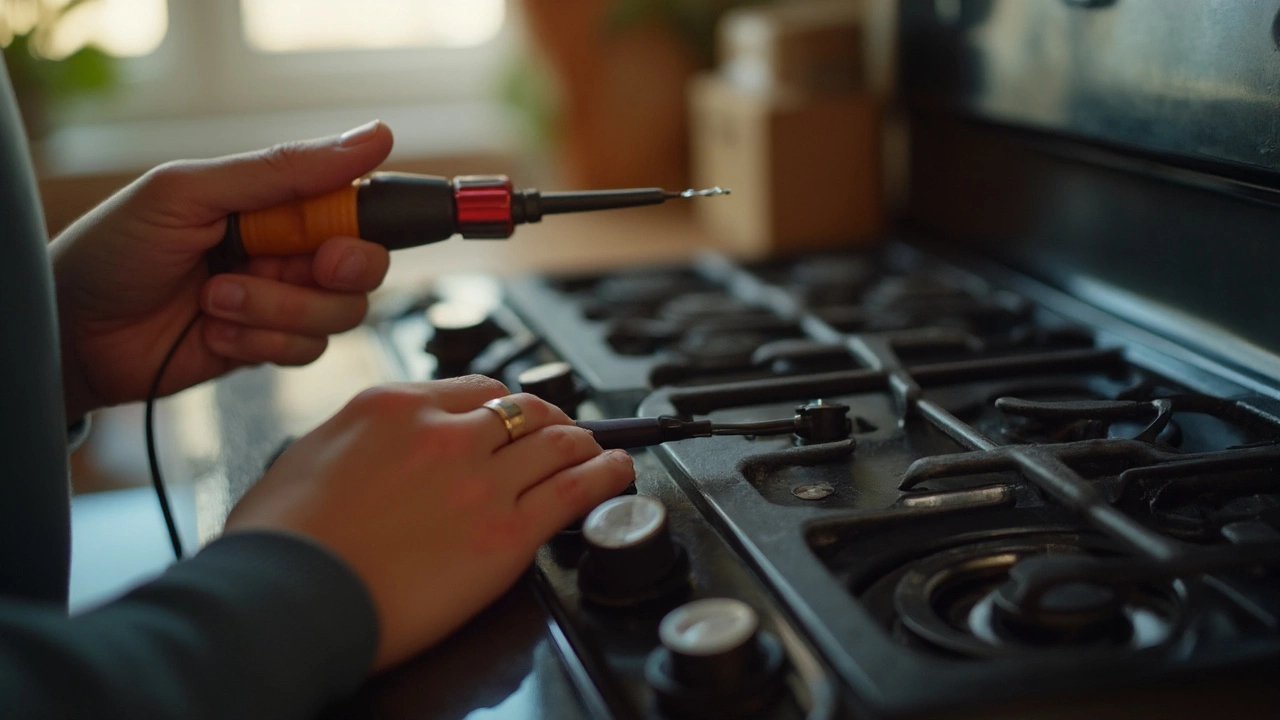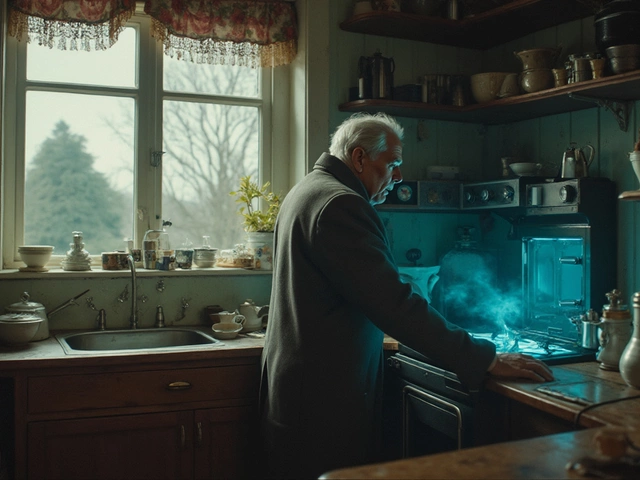Electric stoves can suddenly throw you a curveball—one minute you're roasting chicken, the next, nothing heats up. So, is fixing it just wishful thinking, or do you actually stand a chance at bringing that stove back to life?
Here's the straight answer: most electric stoves are built to be fixed. Whether it's a busted burner, a wonky switch, or a digital display that's lost its mind, plenty of parts can be swapped out without buying a new appliance. Even if you've never opened up the back of your stove, don't stress. Many repairs are simple once you know what to look for. For example, sometimes it's just a loose connection or a fried fuse, which you might spot before you even touch a screwdriver.
Don't rush to order a new stove the first time something goes wrong. The simple truth? Unless the thing is ancient or the whole glass top has cracked in half, it's usually fixable. In a lot of cases, a quick check underneath—there's usually a panel—can reveal the problem. And if you're handy at all, swapping out a bad heating element or cleaning away grime from a connection can make all the difference.
- Why Electric Stoves Break Down
- What Parts Are Actually Repairable?
- DIY Fixes: What You Can Tackle Yourself
- When to Call a Professional
- Red Flags: When Repair Isn't Worth It
- Tips for Keeping Your Stove Running Longer
Why Electric Stoves Break Down
You want your electric stove to just work, but a bunch of common issues can mess with your dinner plans. Most of these problems come down to a few usual suspects, so knowing what goes wrong can save you time and some cash.
Heat, wear and tear, and grime are the main culprits. These appliances handle strong electric currents and high temperatures day in, day out. Over months or years, that wears down components like heating elements and switches. According to the U.S. Department of Energy, "Heating equipment is one of the most taxed parts of any household—it's built tough, but nothing lasts forever.”
"Most electric stove failures come down to repeated cycles of heating and cooling, which stress metal parts and weaken electrical contacts." – Association of Home Appliance Manufacturers
Here are some of the top reasons your electric stove might bail on you:
- Electric stove repair often starts with worn-out elements. If your burner is cold or only half-heating, the element is probably shot.
- Switches and control knobs get gunky or break inside over time, especially if you like to crank the heat.
- Wiring can get loose from vibrations, and connectors can corrode, especially in humid kitchens. That kills the current before it gets to the burners.
- A blown fuse or tripped circuit breaker usually means a quick fix, but repeated electrical hiccups can point to bigger wiring trouble.
- Techy stoves with touchpads or digital panels sometimes glitch if the control board fries or if moisture sneaks in.
Check out how often these problems pop up, according to warranty repair data:
| Problem | By % of Service Calls |
|---|---|
| Burner/Electric element failure | 43% |
| Switches/knobs malfunction | 25% |
| Wiring/connection issues | 17% |
| Control board/display errors | 10% |
| Other (fuses, miscellaneous faults) | 5% |
Grime and food spills that get baked on underneath burners can also cause short circuits or just block the connection. Even something as simple as cleaning the stovetop now and then lowers your odds of a breakdown. So, the next time your stove acts up, you'll have a good sense of where to start looking.
What Parts Are Actually Repairable?
If you’re staring at your electric stove and thinking it’s just a black box, don’t worry—most of its guts are designed to be fixed, not just tossed when something snaps. Manufacturers know folks want electric stove repair, not just full-on replacements.
The most common repairable part is the heating element. Burners that won’t heat up? Odds are it’s a worn-out element that you can swap out with a screwdriver. Most coil and glass-top models let you pull these out and pop in a new one without much fuss.
Next, let’s talk about infinite switches. These are the dials you use to control temperature. Sometimes they wear out or get stuck, making your stove go from off to full blast with nothing in between. Swapping out a busted switch usually takes less than half an hour—and you don’t need any wild tools, just a basic screwdriver set.
Don’t forget about indicator lights. If they’re dead, it might just be the bulb or the socket, both of which are cheap and easy fixes. Some stoves even use standard appliance bulbs you can get at any hardware store.
Oven bake and broil elements are super common repairs for the oven half of your electric stove. If you notice that your oven isn’t heating, those metal rods inside probably need replacing. These are usually secured with a couple of screws and simple connectors.
Then there’s the oven thermostat and temperature sensors. If your oven’s temperature is all over the place, this sensor could be to blame. You can usually unplug it from inside the oven yourself and slide in a new one.
- Heating elements (coils or glass-top burners)
- Infinite switches (temperature control dials)
- Indicator lights (light bulbs and sockets)
- Bake and broil elements inside the oven
- Temperature sensors and oven thermostat
- Control knobs and simple wiring connectors
Even control knobs and basic wiring connectors can be swapped out if they crack or stop working. But here's a tip—anything to do with the main control board or complicated digital displays can be fixable, but parts and labor get pricy in a hurry. If a part looks modular and has screws or clips, chances are, you can replace it yourself. If it’s buried deep or soldered to a board, that might be a different story.
DIY Fixes: What You Can Tackle Yourself
So before you dial up a repair tech, there are a bunch of fixes you can handle yourself—no special tools, just some common sense and a little patience. Kitchens stay functional, and you save good money.
First, safety: Always unplug your stove or turn off the breaker before poking around. It only takes a moment, and nobody wants a shock.
Most of the time, when a burner won’t heat up or runs way too hot, it’s just a bad element or a busted socket. Swapping a burner is usually as easy as wiggling it out and popping in a new one. Coil burners lift straight out, while on glass-top stoves, you’ll likely need a screwdriver to get under the ceramic and reach the element. Just check your model number before you buy parts—they aren’t always universal.
- Electric stove repair tip: If a burner isn’t working, swap it with another of the same size. If the new one works there, your element is fine. If not, the problem’s the socket or switch.
- Broken oven light? Don’t pay for a house call. Screw out the old bulb, match it at the hardware store, and put in a new one.
- Control knobs quit responding? They just pull off. You can order replacements online for less than a pizza in most cases.
- Fuses blown? Many electric ovens have fuses behind a small panel. They’ll look similar to car fuses and are easy to swap. If you keep blowing fuses, though, you might need a pro to check deeper issues.
One common headache is a digital display that won’t light up. Before you panic, pull the stove out and make sure the outlet is tight in the wall. Sometimes the stove just isn’t fully plugged in. Still dead? Unplug, take off the back panel, and look for a fuse or a burnt wire. If you spot damage, that part’s usually replaceable.
Here are some quick stats on the most common electric stove problems, plus how often a DIY fix works:
| Problem | Chance DIY Works | Average Savings |
|---|---|---|
| Burner won't heat | 85% | $80 |
| Oven not turning on | 60% | $100 |
| Control knob issues | 95% | $40 |
| Broken light bulb | 99% | $30 |
| Digital display dead | 50% | $120 |
Anyone with a screwdriver and a little confidence can handle a lot of these repairs. If you get stuck, there are plenty of YouTube videos—just search for your stove’s model and the issue you’re having. The goal is to save money, keep your kitchen running, and get back to cooking something good.

When to Call a Professional
There’s a point when fixing your electric stove goes past what most folks can do safely or easily. If you run into wiring problems or anything to do with the circuit board, it’s time to put down the screwdriver and call an expert. Messing with high-voltage wires can lead to shocks, and you really don’t want to gamble with your safety over saving a few bucks.
Electrical smells, like burning plastic, or a stove that keeps tripping your home’s breaker are strong signs that a pro should take a look. If your oven isn’t heating evenly even after you’ve swapped out the heating element, there could be a deeper electrical problem that’s not visible to the naked eye. Sometimes, the control board or thermostat is fried, and diagnosing those isn’t simple without special gear.
Here’s when you should skip the DIY and get in touch with someone who fixes electric oven repair for a living:
- Electric stove repair involving melted wires or burnt smells.
- The digital display goes totally blank or glitches out.
- You’ve replaced a part but the problem is still there.
- Power keeps cutting out when you turn the stove on.
- The main glass top is cracked (this always needs pro help—don’t risk your hands).
Remember, a tech has the right tools to test voltage, spot hidden breaks, and safely repair live parts. In some cases, they can even save you money by fixing just the broken board or sensor, rather than swapping out an entire section of your stove. If you ever feel unsure, it’s safer and smarter to get a professional’s opinion before things escalate.
Red Flags: When Repair Isn't Worth It
Sometimes, fixing your electric stove just doesn't make sense. You're throwing good money after bad, and a new appliance is the smarter move. So how do you know when to call it quits?
First, check the age. If your stove is more than 15 years old, manufacturers have probably stopped making certain parts. Even if you manage a repair, another piece could fail soon. Home appliance experts often say 10-15 years is the typical lifespan for most stoves.
Cost is another big warning sign. If the technician says it’ll cost more than half the price of a new stove to make the fix, that’s a hard pass. Here’s a quick look at typical repair vs. replacement costs:
| Repair Type | Average Cost (USD) | New Stove Cost (USD) |
|---|---|---|
| Heating Element Replacement | $150 - $300 | $500 - $1,200+ |
| Control Board Replacement | $250 - $600 | |
| Major Electrical Failure | $400 - $800 |
What else signals it’s time to give up on electric stove repair? Here’s a checklist:
- Glass cooktop is shattered (those are pricey and tough to swap out)
- Repeated tripping of circuit breakers, even after pro repairs
- Visible melting or burnt wires inside
- Chassis or body is rusting through or structurally bent
- Replacement parts are discontinued or cost almost as much as a new unit
Don’t forget safety. Any sign of smoke, burning plastic smell, or sparking—especially after a fix—means stop using the stove immediately. That can be a fire risk, and no meal is worth that headache.
In short, if fixing your stove feels like patching up a sinking ship, start shopping instead. Modern ovens use less energy and offer features your old one may never have—like convection, wifi controls, or smart diagnostics.
Tips for Keeping Your Stove Running Longer
Keeping your electric stove running well isn't magic—it's just regular care and a little know-how. Most stoves last 13 to 15 years when they're looked after, but rough handling or forgetting basic maintenance can knock years off that.
- Electric stove repair costs less over time when you avoid big problems with quick fixes and cleaning.
- After every use, wipe down the cooktop and controls. Food spills and grease build up fast, especially around burners and dials, and that grime can block sensors.
- Once a month, unplug the stove and gently vacuum around the burners and under the edges. Loose crumbs and pet hair can heat up and damage wiring or make weird smells next time you cook.
- Stay gentle with the glass top—dropping heavy pans or using it as a cutting board can crack it. Even a hairline crack can get worse under heat.
- If you’ve got coil burners, check their connections every few months. They should fit snugly—if one’s loose, push it in firmly. This keeps heat even and avoids burnt-out spots.
- Pay attention to weird smells, sparks, or uneven heating. These are early clues something’s up and make repairs easier (and cheaper) if you catch them early.
Want to see how small habits make a difference? Check out this quick breakdown showing how simple steps can prevent the most common stove failures:
| Maintenance Habit | Problem Reduced | Annual Savings (USD) |
|---|---|---|
| Cleaning spills weekly | Control short outs | $100–$200 |
| Checking burner fit | Element failure | $30–$80 |
| Not dropping heavy pans | Glass top cracks | $150–$400 |
If you’ve got the manual, hang onto it. Most have a troubleshooting chart and clear maintenance advice that fits your exact stove. And yeah, if something feels off—don’t just live with it. Fixing things early is almost always cheaper than waiting for a meltdown.







